Many people are upping the excitement and challenge of bowhunting by electing to use traditional bows. As a reader of TBM, you likely need little help deciding on a traditional bow, yet most often hunters considering the switch turn to those already involved for advice. Bowhunters who have five or more decades of experience under their belts grew up with recurve bows and likely have their old models in a closet or corner somewhere, but most younger archers have only been exposed to compound bows. How can they determine the style of traditional bow to choose? Or maybe more importantly, which bow fits their style?
The number of types and models of traditional bows is staggering. Yes, there are companies that manufacture large numbers of remarkably uniform bows of varying models, but there are a multitude of smaller companies and individuals that craft bows one by one or in small numbers. Trying every type or model is impossible. Traditional archers often end up with several (if not dozens of) bows because they keep discovering ones that feel or shoot better. I have gone through the same process and now have 40 or 50. At the prices custom-made bows currently demand (and deserve), multiple bows can tie up a small fortune. The majority of my bows are shot only on rare occasions and are relegated to decorative functions most of the time. Three or four are used regularly. Most years only one is routinely taken to the woods. Many archers have related similar experiences so the prospective traditional bowhunter is well advised to take his or her time selecting one that will be a joy to shoot at the present time and into the foreseeable future.
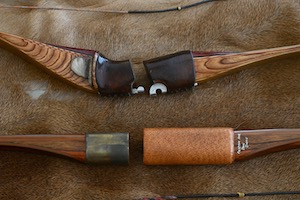
Examples of two-piece take-down bows that join in the riser’s middle.
Traditional bows can be broadly broken into two major categories; longbows and recurves. For the purposes of this article, longbows are those that, when strung but not drawn, maintain the string away from the limbs rather than at the string groove itself. On recurves, the string rides for some distance on the limb. More involved definitions exist but this simple distinction is helpful to the vast majority of archers. Under this definition, flatbows are longbows and bows with siyahs (a fairly long, rigid end of the limb where the string attaches) fall into the recurve category. These two families of traditional bows are composed of countless variations. Let’s consider general characteristics of each group first.
Longbows are simple. Most shoot where your mind points. They can be strung and unstrung easily in the field without special tools. Many of mine are very forgiving; they shoot arrows of a broad range of spines without fishtailing or requiring aimpoint compensation.
Recurves can be thought of as longbows with levers attached to the limb tips. These levers allow the archer to draw stiffer, more powerful limbs without having to endure the entire strain. For example, if you were to cut the recurved portions of the limbs off a bow that pulls 60-lbs at 29 inches and string the remaining part of the bow, it could easily require 80-lbs of force to achieve the same 29-inch draw. Therefore, if a recurve and longbow are both engineered well and pulled the same draw weight, the recurve should propel the arrow faster. (Materials selected can also affect speed, so this rule is not hard and fast.) For some archers, this speed comes at the cost of less naturalness in instinctive aiming. While some archers do string and unstring recurved bows without implements, typically to avoid risk to the bow and to the person bracing, it is best to utilize a bow stringer. It does not take up much more room to carry than an extra string.
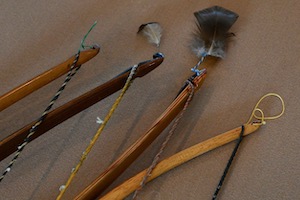
Longbow strings only contact the limbs at the string nocks.
Traditional bows of both types come in an assortment of strengths, lengths, handle designs, and carry weights. Each archer must determine the most pleasing combination. Increased length adds to cast and comfort, but too much length can become cumbersome. The hunter has to consider where the bow will be drawn. In a tree stand? A blind? In thick brush? Typically, the heavier the bow (not draw weight here, but mass), the easier for the archer to keep the bow from twisting or moving upon release. The downside is that weight makes it heavier to tote and maybe not as quickly maneuverable. Similarly, wider handles are less subject to rotation upon release than skinny handles. The effect on accuracy of the bow twisting a quarter inch with a grip five inches in circumference is not nearly as noticeable as the same twist when the circumference is only three inches. So not only is the effect of rotation diminished with larger handles, but the tendency to rotate is less.
Draw weight is an obvious variable which depends largely upon the strength of the individual. Most experienced bowhunters will advise against being over-bowed. In fact, when I asked Roger Fulton of Black Widow Bows what advice he would offer someone transitioning to a traditional bow, his first suggestion was to be sure not to select too strong of a draw weight. The weight that seems easy at the range or at home might be more difficult from the awkward positions hunting imposes, or in freezing temperatures, or when the draw must be made smoothly and stealthily. The modern materials of many traditional bows allow for fast arrow flight without exceptional draw weight. Compound bowshooters are often tempted to maintain the draw weight to which they are accustomed, not realizing the substantial difference between getting the bow quickly over the peak weight ‘hump’ when drawing and holding the entire weight at full draw.
It might be worth pointing out two things at this juncture to people transitioning from compounds. Because of the let-off on compound bows, the arrow is loaded gradually upon release; it is already moving fast before peak weight is unleashed. With a traditional bow, the arrow receives the full jolt of the draw weight while it is sitting motionless, resulting in greater flexing of the arrow. Therefore, finding arrows with the correct spine is extremely critical. Heavy draw-weight bows can be harder to tune. The other aspect is that the incredible arrow velocity of a compound is missing from trad bows, so increased arrow weight becomes much more important for good down range penetration.
In addition to choices of strength, length, and handle design, the materials from which the bow is made must be decided upon. There are selfbows made simply from the wood of the stave, fiberglass reinforced bows, and even bows with carbon fiber over wood or foam cores. Hundreds of natural woods utilized for risers and limb laminates offer a limitless variety in performance and appearance. Even metal risers are available. Both wooden and metal risers offer choices of grip shape and size. Again, the variation is nearly overwhelming. A prospective traditional archer should endeavor to try as many different bows as possible. One way to accomplish this is to attend some traditional bow events. Chances are high that many bow styles will be present, and most archers are delighted to allow for inspection and trial of their pet bows.
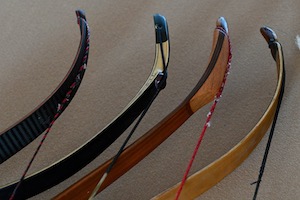
Recurve strings make contact with the limbs a short distance from the string nock when braced, not drawn.
It should be pointed out that these nearly limitless combinations of shape, length, draw weight, and materials affect the performance of the bow in countless ways. An archer will discover differences in the speed each bow propels an arrow, in the hand shock upon release, in the pleasure of the shot, in the noise the bow produces, in the comfort of the grip and the draw, and in the tendency of the bow to direct the arrow to where the archer envisions.
In recent times, manufacturers came up with a standard methodology to make limbs interchangeable. It is called the ILF system, short for the International Limb Fit System. All ILF limbs fit any ILF riser regardless of the manufacturer. The advantage of this system is that an archer who discovers that limbs of a different length or draw weight might suit them better does not need to purchase an entire new bow. Some archers prefer two sets of limbs; a stronger set for practice and summer shooting and then a set with reduced weight for actual hunting. Some archers even use the same riser for both longbow and recurve limbs.
A large number of individual bowyers have small scale operations that craft a few bows at a time. Purchasing one of these bows can have advantages. Many are distinctive and unusual which adds to the owner’s pride and enjoyment. A knowledgeable and experienced bowyer can create a bow that exactly fits the archer’s needs. This holds particularly true when the bowyer and archer can meet. The archer provides feedback about the ‘feel’ as various models are tried, and the bowyer can analyze the archer’s draw and shooting style. I know two such bowyers, Eddie Francisco in the Tallahassee area and Tom Allen in Melbourne. I would heartily endorse both. They are perfectionists; their bows perform phenomenally and look like works of art. Although Tom has been building bows for over four decades, he modestly attributes much of the credit to knowledge gleaned from working with Mike Fedora and Jay St. Charles. Eddie has been making bows for a long time as well.
Unfortunately, in recent years, personal tribulations limited his ability to continue crafting bows. However, he is now re-setting up his shop, ready to resume making bows.
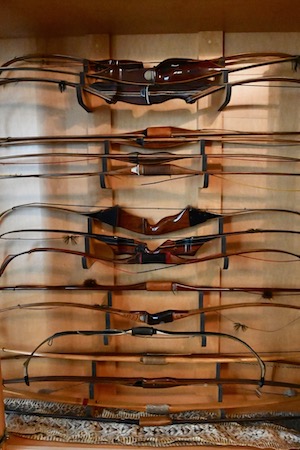
It is far too easy for a traditional archer to
accumulate multiple bows as he or she tries
various styles and makes. Taking time to find the
best one from the start makes sense and saves money.
Bigger manufacturers offer advantages as well. Quite often, with their inventory and large-scale production, the waiting time between ordering and receiving a bow is shorter. While they do produce more bows, these companies still make each one specifically to the customer’s specifications. I have several Black Widow and Bear Archery bows in my collection. They perform beautifully. Black Widow Custom Bows spokesperson, Roger Fulton, told me of a demo program they have to help archers choose the correct bow. The customer pays for a trial bow and the shipping charges, but the cost of the bow is refunded should it not meet the archer’s needs. Roger told me most customers fall in love with their bow and it is rare for one to be returned. Even so, it is reassuring to know a bow ordered sight unseen can be returned
Another aspect the archer may wish to consider before deciding on a bow concerns the extent he or she plans to travel to distant hunting grounds. One-piece bows are easy and typically less expensive than take-down models, but are more cumbersome as luggage, usually becoming an independent parcel. For air travel, the extra charges due to multiple bags for just one flight offsets the increased price of a take-down model. Take-downs can be two pieces which join at the handle or three pieces consisting of two limbs and a riser. My take-down models easily fit into a case with arrows, which is then stashed in my duffle. The result—no extra baggage!
As you can see, there are many considerations in selecting the perfect traditional bow. The staggering number of variations can be mind-boggling. It might be best for an archer to list the aspects he or she desires in a bow and rank them by level of importance as a starting point. Then, when talking to an archery shop representative or bowyer, the characteristics valued most highly can be communicated and the expert can help narrow down the choices.
Frequent contributor Tim L. Lewis recently published a second edition of his book, Tales of Trails: Finding Game After the Shot.


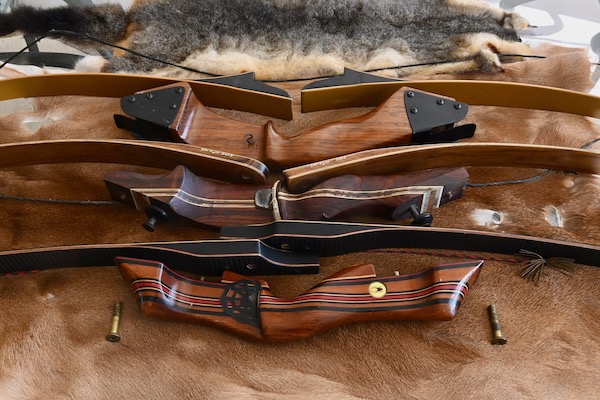
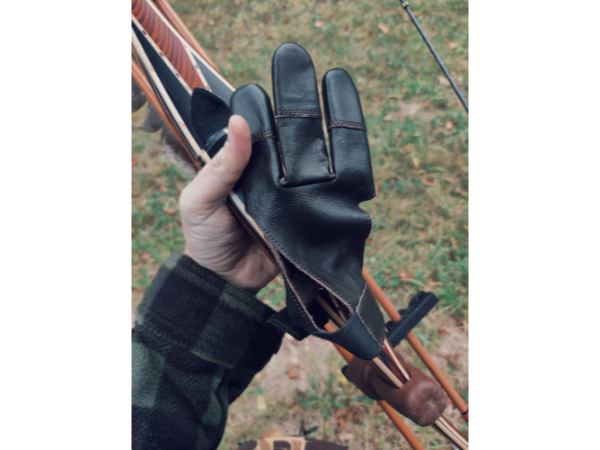



Leave A Comment